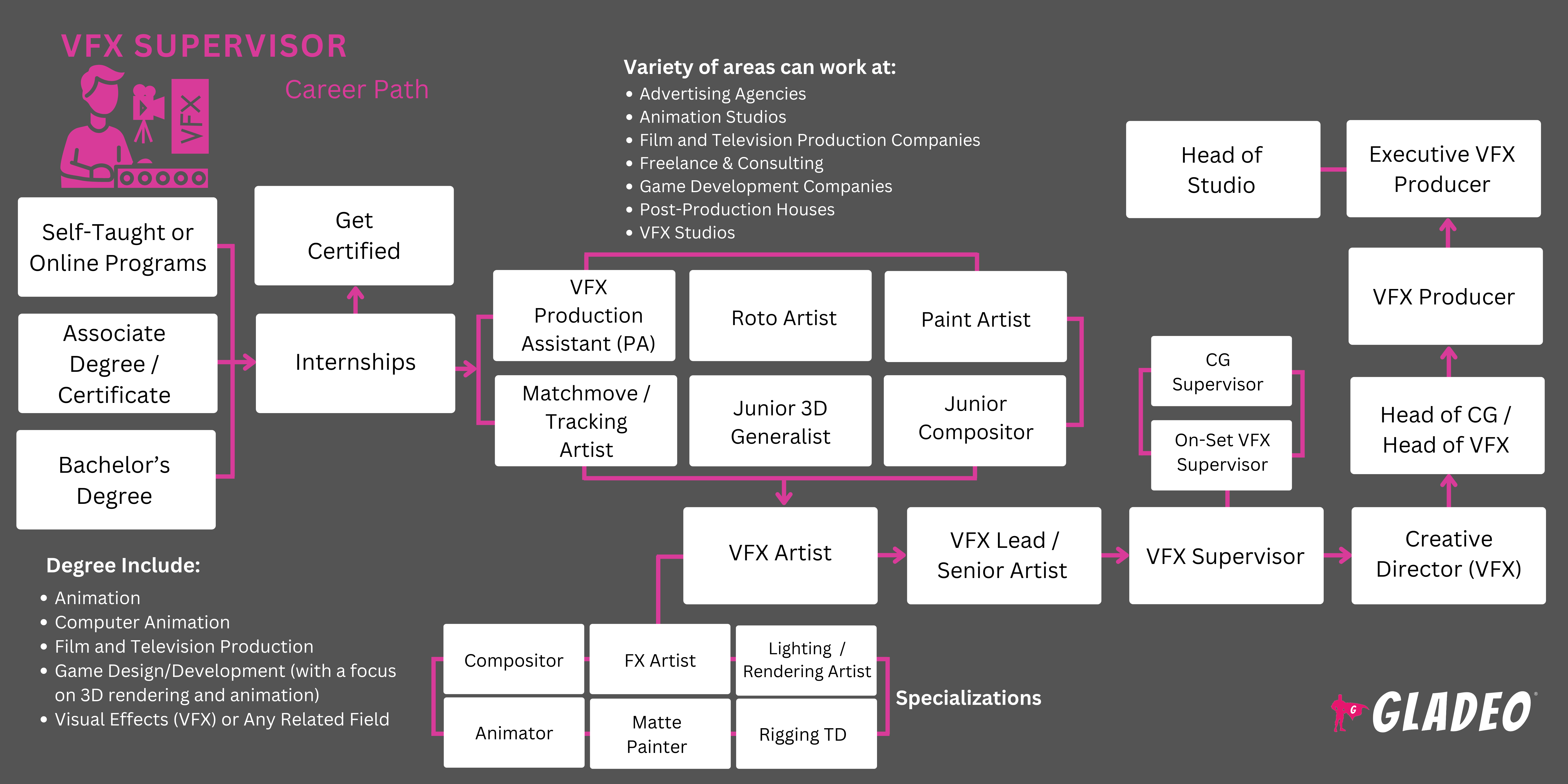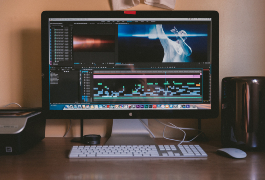Spotlights
Visual Effects Supervisor, CG Supervisor, FX Supervisor, VFX Producer, VFX Director
If you’ve seen a blockbuster Hollywood movie in the past 20 years, it was probably loaded with visual effects (VFX). That trend is accelerating, with the footage in 2019’s Avengers: Endgame reportedly featuring a whooping 90% VFX and computer-generated imagery (or CGI, a subcategory of VFX). Unlike special effects — which are done practically and in-scene during filming — all VFX are done during the post-production process after filming has wrapped.
This cinematic magic is made possible by VFX Supervisors who work closely with producers and directors to create or enhance scenes that might be impossible to pull off in real life. Much of their work involves overseeing CGI and other effects during the lifecycle of the film, including pre-production script reviews and planning which scenes will need effects added later. They also tidy up special effects footage so it appears seamless in the final cut.
VFX Supervisors are pretty high up the food chain, but in terms of creative decision-making, it’s their job to bring the producers’ and directors’ visions to life!
- Working on visual media, possibly for millions of people to see.
- You are the “boss” leading several dozen members of a visual effects crew
- Often able to travel and meet many different people
- Working to make a unique vision come to life on screen.
A VFX Supervisor may work directly on set, or at a separate Visual Effects Studio. Each day can be very different from the one before. Their work can also shift dependent on if they are working on a separate film, a full TV Series, or other visual media. They could work on a short portion of a complex shoot for a few days or a single movie for up to two years.
Pre-Production
During pre-production, a VFX Supervisor will meet with the producers and directors of the project. They will review every shot of the film with this team to determine when and where an effect will need to be added after shooting. They will work with VFX artists to craft concept art, prototype computer models, and any other planning that needs to take place.
During Filming
During filming, the VFX Supervisor makes sure each shot is able to have effects added. Sometimes, shots may change which can make it more difficult for the VFX team to do their job. There may be a need to reshoot a scene with different elements such as a green screen to make it easier for the VFX artists to do their job.
Sometimes, VFX is able to start before a movie is finished filming.
Post-Production
Because a VFX Supervisor is responsible for all visual effects, they spend much of post-production reviewing the work of the VFX artists. The Supervisor will make sure all the added effects meet the level of quality a director and producer is looking for. However, they also must make sure their artists are meeting time deadlines. There can be long days and hours for Visual Effects workers!
Typical Duties
- Review scripts for films, TV shows, music videos, commercials, and other video media where effects will be needed
- Assist with developing bids for the VFX studio wanting to work on the production’s effects, when applicable
- Discuss ideas with the production’s writers, producers, and directors
- Go over budgets and timeframes with the unit production manager
- Collaborate with applicable crew or directors as needed to ensure scenes are shot in a way that allows for adding VFX later
- Suggest changes to filming, such as using a green screen backdrop, so VFX can be integrated smoothly
- Ensure the creative vision is understood and captured by the VFX production management department
- Oversee the development of concept art and CGI and inspire artists with ideas
- Keep projects on track and stay responsive to change requests
- Conduct quality control checks and sign off on work that’s ready to be shown to the producers and directors
- Stay engaged with other departments including stunt coordination, special effects and prosthetics, wardrobe, hair and makeup, etc. to ask questions and make sure VFX embellishments are done correctly
- Add VFX over actors’ real features for motion capture (“mocap”) performances or de-aging
Additional Responsibilities
- Stay on top of new developments in the industry
- Watch what other VFX companies are doing to draw inspiration
- Help actors visualize how the final cut of a shot will appear after effects are adding, in case it helps them understand the scene better so they can adapt their performance
- Ensure new artists are trained and up-to-speed on the work that needs to be done
Soft Skills
- Written and Oral Communication
- Interpersonal Skills such as diplomacy and networking
- Attention to Detail
- Planning and Organizing
- Adaptable/Flexible problem solving
- Ability to inspire others
- Active listening
- Collaborative
- Conceptualization skills
- Confidence
- Creativity
- Decisiveness
- Detail-oriented
- Flexibility
- Leadership
- Patience
- Persistence
- Planning and organization
- Problem-solving skills
- Strong communication skills
- Teamwork
- Visual and written storytelling
Technical Skills
- Film/Video Production skills, including editing
- Able to use complex computer animation and editing software such as Adobe Creative Cloud or AfterEffects
- Communication technology via computer, phone, or software like Slack.
- Computer coding and VFX pipeline
- Programming languages such as Python and C++
- Expertise with professional VFX programs such as Adobe After Effects, Maya, Nuke, and others
- Familiarity with design, special effects, and post-production processes
- General understanding of the roles, responsibilities, and challenges of all critical departments and crew members, including production design, wardrobe, art, makeup, sound, special and visual effects, set decor, stunt coordinators, cast directors, etc.
- Knowledge of video camera equipment and filmmaking software, including professional editing tools
- Project management skills
- Technical knowledge of framing and staging shots
- Television/Film Studio
- Video Game Studio
- Visual Effects Studio
- Advertising and PR firms
- Motion picture studios
- Performing arts industries
- TV broadcasting
- Video game companies
- VFX companies
As with many jobs in the entertainment industry, becoming a VFX Supervisor can be a long and challenging road. You may find it difficult to find an entry-level position at a VFX studio and will need to work at creating an effects reel or portfolio independently. You may also start work on film sets as a production assistant or runner.
A runner may only be responsible for message delivery and fetching coffee. If you lack a network and connections, it will take time to build it. Enthusiasm and a positive attitude are key to moving up in the field.
VFX houses also provide long hours. You may start at 9 am and work past midnight during times when deadlines are approaching. If you are working as a VFX artist, it can take many years of this lifestyle before you are able to move into a Supervisor role.
A VFX Supervisor has very little further to go in the VFX field, as they are often the top worker in a VFX studio. This is often the role they want to end their career in, but some may move on to be VFX Producers or Film Directors.
If you continue to do good work, your main advancement will be bigger and better-known projects.
As effects continue to improve in realism, there is a greater need for these artists and supervisors. Especially with the recent trend of action and superhero movies, VFX has become essential for creating realistic-looking computer art.
However, there has been pushback by some filmmakers to return to practical effects. Some VFX Supervisors see this as competition, but others see it as an opportunity. Practical effects often need touch-up work done after filming is completed by VFX houses.
As Virtual Reality offerings increase, there is more opportunity for VFX artists to work in this field as well. This includes Augmented Reality (AR), which involves a visual overlay in real-time over what an individual sees in real life. While perfect for entertainment, it also is being used in the field of education.
Streaming platforms have rocked the entertainment industry, with high-quality scripts, boosted production values, and fat checks luring big-name producers, directors, and stars. This shift has been a boon for the VFX industry, which is needed to produce film-quality effects for shows on Netflix, HBO Max, Disney+, Apple TV, Amazon, and more.
Where once their work was reserved mostly for sci-fi films, now VFX gurus are lending their wizardry to almost every type of show being produced today. Many effects look so natural, viewers don’t realize they are seeing them — even in sitcoms and dramas. Of course, VFX really stands out the most in action and superhero flicks, which have seen a massive surge in recent years.
While some old-school filmmakers lament this trend and prefer practical special effects, even these stalwarts of cinema are willing to venture into VFX territory when it suits their purposes (with a good example being when acclaimed director Martin Scorsese criticized Marvel films after using extensive de-aging VFX throughout his crime drama The Irishman).
The video game market continues to be a cash cow for VFX companies, too. Meanwhile, Augmented Reality is a new frontier for VFX explorers, for it involves visual overlay in real-time over what an individual sees in real life.
VFX Supervisors were probably huge movie and TV buffs growing up. They may have enjoyed making amateur videos for YouTube and adding effects with free software tools. Like other future film and TV workers, they were likely innovative, driven, and comfortable with a little chaos in their daily activities. In school, they might have been involved in computer and audiovisual clubs, artistic extracurricular activities, or creative hobbies like drawing or graphic design.
There are several paths a person can take to become a VFX Supervisor.
- Bachelor’s Degree – Visual Effects/Motion Graphics, film and television production, computer animation
- This will often be from an Art School or college specializing in Art
- This is highly recommended and can be the easier path long term.
- Other Majors can work as well, but you will need to demonstrate your skills.
- Most VFX Supervisors need at least a bachelor’s in visual effects/motion graphics, film and television production, or computer animation (often from art or arts-focused school)
- Additional ad hoc certifications such as CG Masters’ 12-week 3D Foundations Certificate can bolster your credentials if you majored in something else
- Common VFX program courses may include:
- 3D design
- Chroma keying techniques
- Clean plate and wire removal
- Cloth FX
- Compositing
- Day-night conversion
- Digital design
- Digital makeup
- Match moving and camera tracking
- Maya and NUKE integration
- Particle effects
- Photography
- Projection for visual effects
- Pyrotechnics
- Rotoscoping
- Set extension
- Stereoscopic effects
- Time warping effects
- In addition to a degree, a strong portfolio or effects reel may be needed to demonstrate capabilities
- Studying animation and anatomy is also useful
- Students should master professional VFX programs such as Adobe After Effects, Maya, or Nuke, as well as graphics software like Gimp or Blender
- Many students plus up their skills through ad hoc online courses, self-study and practice, or working on independent video projects
- Being a supervisor of a VFX crew requires managing and coordinating lots of people and many activities. Courses in communications, leadership, team building, conflict resolution, and project management can be helpful
- Most VFX Supervisors have years of experience working on sets in other roles. Many get their start through internships
- Consider the cost of tuition, discounts, and local scholarship opportunities (in addition to federal aid)
- Think about your schedule and flexibility when deciding whether to enroll in an on-campus, online, or hybrid program
- Check out the program’s faculty awards and accomplishments to see what films, shows, or other VFX projects they’ve worked on
- Look closely at the school’s facilities and the equipment and software that students train on
- Review job placement stats for graduates and details about the program’s alumni network
- Take art classes, including illustration.
- Computer coding and programming.
- If your high school offers 3D computer animation and/or media productions, these are very important.
- Some Colleges offer Bachelor’s Degrees in Visual Effects/Motion Graphics
- A mix of film, art, and computer classes can help you gain the skills needed.
- As early as possible, curate a portfolio of work as well as a “reel” of any video you produce with visual effects.
- Stock up on courses in art, illustration, graphic design, computer coding and programming, and communications
- Don’t neglect to develop your soft skills! Participate in activities where you can learn about teamwork, leadership, project management, organization, time management, and conflict resolution
- Sign up for audiovisual clubs, theater productions, or any opportunities where you can get hands-on experience with video production
- Take How Visual Effects Work in Film: A Guide to the 4 Types of VFX from MasterClass
- Learn from self-study and practice at home. Find friends and community members who need VFX added to their projects
- Consider freelancing to gain more experience while getting paid!
- In college, if you major in VFX then round out your education with classes on film, art, animation, photography, and computer science
- Enroll in confidence and resilience courses, so you’ll be able to direct teams under stressful circumstances
- Study books, articles, and video tutorials (see our list of Resources > Websites)
- VFX Magazine and VFX Voice are popular publications to check out
- Get to know the ins and outs of the major department involved in filming TV shows, ads, documentaries, etc.
- Watch a variety of TV shows and behind-the-scenes segments, when available
- Take notes on the VFX you see then research how they were produced
- Get familiar with some of the top VFX companies. Read their histories for ideas and inspiration
- Ask a working VFX Supervisor if they have time to do an informational interview with you
- Become familiar with as many VFX techniques and programs as you can
- Launch an online portfolio to showcase your skills and work
- Apply for film internships until you land one!
- Attend film festivals and film school open events
- Join professional organizations to learn about trends and grow your network

- Networking is the best way to get hired:
- Log internships as often as possible if you are in school.
- Create an online presence with a portfolio, and use social media to build connections with professionals in the industry.
- Stay positive and confident in your worth – try avoiding doing work “for the exposure.”
- Use sites like Upwork for Fiverr to offer freelance work you can use for your portfolio.
- With a degree, network and solid portfolio, you may be able to land a job within a VFX house as an artist.
- Be ready to work as a Production Assistant or Runner to get your foot in the door.
- A VFX Supervisor is often at the top of the VFX department or production house. You will likely start at an entry-level position as a Production Assistant (PA) or Runner. This position may not include any VFX work at all!
- You will need to take the initiative to continue maintaining a portfolio of projects in your spare time. This can be character design, short effects reels, or any other work that shows your skills. Even fan art of a favorite property can demonstrate your skills.
- Networking and building relationships in the industry will help just as much. You will need to show you are easy to work with and willing to take direction when needed. It will take a combination of skills and personality to move up in the industry.
- Finishing internships and networking are great ways to improve your odds of finding work
- If you’re still in school, apply for jobs on set (such as a production assistant or runner) just to get your foot in the door and start making connections
- If you have enough academic credentials and a solid portfolio, go ahead and apply for VFX artist jobs
- Establish your reputation online with a stunning portfolio and plenty of social media sharing
- Gain experience through freelancing on Upwork, Fiverr, and related sites
- Let your network know you are looking for jobs or internships! Per CNBC, “Research shows that 70% of all jobs are not published publicly on jobs sites and as much as 80% of jobs are filled through personal and professional connections”
- Enter film festivals and get published in industry journals or on popular websites
- Be ready to relocate, depending on your first job goals
- Hop on Quora or online VFX forums to ask for job advice from working VFX artists
- Check out film job sites and job portals such as Indeed, Simply Hired, and Glassdoor
- Look at the career pages of the VFX companies you’d like to work for
- Ask your professors, supervisors, and peers if they’ll serve as personal references
- Talk with your film school or college’s career center for help with resumes, mock interviews, and job searches
- Review VFX artist resume templates to get ideas for formatting and phrasing
- Study VFX artist interview questions to prepare for those crucial interviews
- Always dress appropriately for job interview success!
- Don’t rush things. To move up from VFX artist to Supervisor takes time
- The most certain way to move up is to ensure your talent and creativity are seen via constant networking with fellow industry professionals
- Have your portfolio and reels up-to-date and actively search for opportunities
- Build trust by delivering awesome VFX work on time, on budget
- Capture the imagination of producers and directors. Make them want more work from you
- Continue to hone your craft while learning about everyone else’s roles
- Knock out additional education and training to enhance your technical and creative skills
- Treat people with respect and stay calm under pressure
- Build a reputation as a collaborative artist and leader who brings people together around a cohesive vision
- Work on as many projects as you can to expand your portfolio of work
- Watch and learn from more senior VFX experts
- Keep growing your professional network and tackling larger, more ambitious projects
- Make yourself available for film festivals, local events, conferences, and workshops
- Join professional organizations and win recognition that’ll look great on your resume
Websites
- The Professional Association for Design
- National Association of Schools of Art & Design
- Cinefex
- Academy of Motion Picture Arts and Sciences
- ACCESS VFX
- Action-Cut-Print
- American Film Institute
- Animal Logic
- Animation Guild
- Animation Skillnet
- Art of VFX
- Association for Computing Machinery Special Interest Group on Computer GRAPHics and Interactive Techniques
- Brand New School
- Cartoon Network Studios
- Cinephilia and Beyond
- Digital Domain
- Directors Guild of AmericaFilm Collaborative
- DreamWorks Animation
- Encore VFX
- Filmmaker IQ
- Filmmaker Magazine
- Filmmakers Alliance
- Film Riot
- Film School Rejects
- Filmspotting
- Framestore
- FX Guide
- IndieWire
- Industrial Light & Magic
- Lucasfilm Animation
- Luma Pictures
- Method Studios
- Moving Picture Company
- National Endowment for the Arts
- Nickelodeon Animation
- No Film School
- Pixar
- Rough Draft Studios
- Shooting People
- Society for Animation Studies
- Society of Motion Picture and Television Engineers
- Sony Pictures Imageworks
- Student Filmmakers
- Studio Ghibli
- VFX Magazine
- VFX Soldier
- VFX Voice
- VFXWorld Magazine
- Visual Effects Society
- Walt Disney Animation Studios
- Warner Bros Animation
- Weta Digital
- Whiskytree
- WIRED - Design FX
- Zoic Studios
Books
- Digital Compositing for Film and Video: Production Workflows and Techniques, by Steve Wright
- Inside VFX: An Insider's View Into The Visual Effects And Film Business, by Pierre Grage and Scott Ross
- The Filmmaker’s Guide to Visual Effects: The Art and Techniques of VFX for Directors, Producers, Editors, and Cinematographers, by Eran Dinur
Being a VFX Supervisor means long hours and tons of pressure to get things “right” (which is a very subjective term in this business). It can be a highly rewarding and dynamic profession, but for those who want something a bit less hectic, consider the following related occupations!
- Video Game Designer
- Visual Effects Artist – Stay at this level
- Other position in Film/Video Production (If you learn the skills)
- Sound Design
- Costume Design
- Practical Effects
- Computer Analytics – if your knowledge base is more computer-based.
- Book Illustrator
- Graphic Design for Companies
- Freelance Work
- Art Director
- Choreographer
- Costume Designer
- Film and Video Editors
A career in film can be challenging. VFX Artists work long hours and don’t always get the credit they deserve. It is highly likely you will start at an entry-level position, even with a degree. You may also find yourself working in a non-VFX position as you look for one.
The best tools are your own creativity and networking. If you are able to create a good portfolio, you will be ready when the right opportunity comes along. A portfolio of all your best work is a good thing to have, but be ready to pick 1-2 pieces from it that demonstrate your skills the best when applying for a job.
Keep a strong network with others in the industry. A good internship in a college program will help with this. While it is certainly possible to find a position without college, the experience will help you develop connections and assure future employers you have learned the skills necessary to do the job.
To move up from VFX Artist to Supervisor will take time. In addition to skills and networking, you will need to demonstrate an ability to lead others and to help meet a cohesive vision.
Newsfeed

Featured Jobs

Online Courses and Tools







